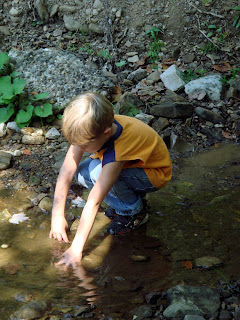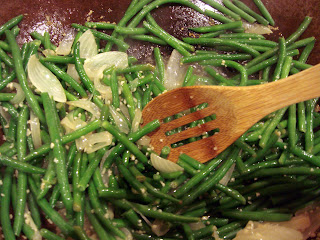Sunday, September 28, 2008
Friday, September 26, 2008
Curried Lentils
Thursday, September 25, 2008
Walking Stick
Scientific Name: Varies
Insect Order: Phasmida
Description: Walkingsticks are slow moving, wingless, and stick-like, with long, slender legs and long thread-like antennae. Their color, form and behavior allow them to hide from predators. They vary in color from green to brown and may grow to be almost 4 inches long, the longest insect in the United States!
No other species can be confused with walkingsticks. They do not have front legs modified for capturing prey as do praying mantids and the thread-legged bug (Heteroptera: Reduviidae).
Life Cycle: In the fall, black or brown seed-like eggs are dropped by females to the litter below host plants. Nymphs hatch in the spring and develop through several stages (instars) before becoming sexually mature adults. One generation is produced each year. Walkingsticks occasional defoliate some trees and shrubs.
Habitat, Food Source(s), Damage: Nymphs and adults have chewing mouth parts and feed on leaves. In the spring, young nymphs feed mainly on understory shrubs. Later instar nymphs and adults feed throughout the crown of host plants. Host plants include apple, basswood, birch, dogwood, hackberry, hickory, locust, oak, pecan and wild cherry. Outbreaks are cyclic.
Wednesday, September 24, 2008
New Portfolio Blog!
Linda Campbell and I are working together to create a blog that can be evaluated for homeschool assessment. Rather than post all the written work on this blog, I have created a portfolio blog where I will post pictures and samples of their work in all subject areas and update it on a monthly basis. I have completed the month of September minus some captions that I will add on Friday.
Linda is calling this type of assessment "Distance Portfolio Review" Check it out and give me your feedback.
http://www.hydeportfolio.blogspot.com/
Meditate your peace.
Linda is calling this type of assessment "Distance Portfolio Review" Check it out and give me your feedback.
http://www.hydeportfolio.blogspot.com/
Meditate your peace.
MUKA-WA TUM-BE-SHI ALIEN?!
1 cup flour
1 rounded teaspoon baking powder
1/2 teaspoon salt
3/4 cup warm water
Mix
Add enough flour so that dough doesn't stick to hands
Form into a ball
Flatten out to fit inside a skillet
Slide into 1/2" of smoking hot Crisco
Fry on both sides till brown
Roll in cinnamon/sugar while hot or serve with jelly
Friday, September 19, 2008
Wednesday, September 17, 2008
Back Porch Beauty
Flower/Food Coloring Expreriment

You know that plants need water to grow, make seeds, and stay healthy.
Fill a plastic container with water and add a few drops of food coloring.
Cut a small piece of the stem off of the flower.
Put the flower in the container of food coloring and water.
Check every few hours to see how the petals are changing color. The only way the petals can change color is if the food coloring travels up the stem and goes to the petals.
After about one day, the petals of the flower will turn from white to the color of the food coloring.
Here's how this works. The leaves and petals of plants have lots of small holes called stomates. They're too small to see. Water evaporates through these holes. This is called transpiration. After the water evaporates, the plant needs more water to grow.
If the flower is planted in soil, the roots of the plant get the water from the soil and then the water travels up through its stem.
But, if the flower is in a container of water, it doesn't have any roots so it just sucks up the water through its stem.
So, now when you see a flower that's an unnatural color, like a bright green carnation on St. Patrick's Day, you'll know how it was made. You can also dye a flower two different colors by splitting the stem in half and putting it in two different containers of colored water.
Tuesday, September 16, 2008
Gypsy Stories

My girls have always liked story time. Today, I didn't have a particular book in mind, so I went to the shelf and looked for something interesting. My eyes connected with a book titled Sister of the Birds by, Jerzy Ficowski. It was an old library book I had purchased at a book sale. I had never read it but you just can't go wrong with a good gypsy tale. So we cozied up on the couch and read chapter 1, Sister of the Birds, and my girls were so taken by the story, I think they must have been gypsies themselves in another time. They can't wait for story time tomorrow! Here is a list of the other chapters in this book:
The Mother of the Sun
Where Blond People Came From
The Magic Box
The Rose and the Violinist
Andrusz Who Disliked Beans
There is also a Guide to Pronunciation of Gypsy Words, About the Author, About the Translator, and About the Artist.
The Song of Wandering Aengus
I went out in the hazel wood,
Because a fire was in my head,
And cut and peeled a hazel wand,
And hooked a berry to a thread;
And when white moths were on the wing,
And moth-like stars were flickering out,
I dropped the berry in a stream,
And caught a little silver trout.
When I had laid it on the floor,
I went to blow the fire aflame,
But something rustled on the floor,
And some one called me by my name:
It had become a glimmering girl
With apple blossom in her hair
Who called me by my name and ran
And faded through the brightening air.
Though I am old with wandering
Through hollow lands and hilly lands,
I will find out where she has gone,
And kiss her lips and take her hands;
And walk among long dappled grass,
and pluck till time and times are done
The silver apples of the moon,
The golden apples of the sun.
William Butler Yeats
Thank You Shanda!
Because a fire was in my head,
And cut and peeled a hazel wand,
And hooked a berry to a thread;
And when white moths were on the wing,
And moth-like stars were flickering out,
I dropped the berry in a stream,
And caught a little silver trout.
When I had laid it on the floor,
I went to blow the fire aflame,
But something rustled on the floor,
And some one called me by my name:
It had become a glimmering girl
With apple blossom in her hair
Who called me by my name and ran
And faded through the brightening air.
Though I am old with wandering
Through hollow lands and hilly lands,
I will find out where she has gone,
And kiss her lips and take her hands;
And walk among long dappled grass,
and pluck till time and times are done
The silver apples of the moon,
The golden apples of the sun.
William Butler Yeats
Thank You Shanda!
Sunday, September 14, 2008
Subscribe to:
Posts (Atom)

































